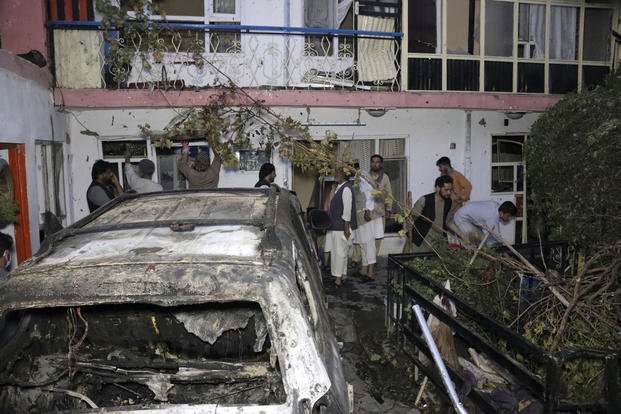

A new central office in the Pentagon will work with the military and battlefield commanders in an attempt to limit the number of civilian casualties overseas following recent U.S. strikes that killed women and children.
Plans for the so-called Civilian Protection Center of Excellence were unveiled Thursday following a months-long review ordered by Defense Secretary Lloyd Austin in January. As part of a wider effort to limit casualties, the department plans to stand up the center within a year and staff it with 30 personnel to start, but future growth could depend on Congress.
Civilian deaths were thrust into the spotlight again after U.S. Central Command launched an airstrike on a compound in Kabul during the chaotic military withdrawal last August that mistakenly killed 10 innocent Afghans, including children. The strike came three days after a suicide bomber killed 13 U.S. troops guarding the Kabul airport.
Read Next: VA Pushed to Make It Easier for Veterans to Get Reimbursed for Travel to Appointments
The Pentagon review was also spurred by a string of other reports of civilian casualties, including a Rand Corp. study that found at least 774 civilians died in the climactic battle in Raqqa, Syria, between U.S. coaltion forces and the Islamic State terrorist group in 2017, and a New York Times report that a 2019 U.S. strike in Baghuz, Syria, killed about 70 civilians, including women and children.
The center, which was recommended by Rand, will coordinate military-wide efforts to reduce the casualties and will work directly with operational commands, according to the plan approved by Austin and released Thursday. That could include deploying personnel to active operations to assist in planning.
“We would envision having somebody or probably a group of people who are experts in the civilian environment that are sitting next to the operators, the threat-focused intel folks, the lawyers, as they’re really developing [plans], whether it’s an individual operation or a campaign,” a senior defense official said during a briefing to the press.
Deployable “standby personnel” within the military services who have been certified by the new center could be sent out to assist commands when requested, the Pentagon plan says.
Austin also directed the Pentagon to create uniform methods of investigating civilian casualties and a uniform way of collecting and storing data on the incidents. The department must also review how it provides condolence payments to victims and how it publicly acknowledges the incidents. Austin put Army Secretary Christine Wormuth in charge of a steering committee that will oversee the changes.
Reducing the number of innocents who are killed and injured in U.S. conflicts overseas will be “critical to succeeding and winning on the modern battlefield,” the official said.
The post-9/11 wars in Iraq and Afghanistan were marred by U.S. strikes that killed civilians. Violent urban battlefields such as Raqqa, where the population was scattered among dense urban terrain, made it difficult for American troops to always know exactly what they were striking. The widespread use of drones in areas without U.S. troops on the ground also meant strikes were made with patchy intelligence at times, increasing the risk of innocents being hit.
The military has long claimed it makes every effort to avoid harm to civilians. But the recent high-profile botched strikes — the head of Central Command publicly apologized for the Kabul strike, calling it a tragic mistake — and the Rand review released in January found that the military did not adequately use data and lessons it learned over the past two decades to reduce unnecessary civilian casualties.
Still, the center of excellence will take several years to fully establish.
The initial core staff of 30 are slated to join the center in the coming fiscal year, which starts in October, and will focus on a study to find out how much manpower it needs. The following fiscal year, which is calendar year 2023-2024, the center will lay out a budget and the Pentagon will make any needed budget proposals to Congress.
“We think this is in the tens of millions [of dollars] per year, so not something that is overwhelmingly large or expensive relative to what we spend, of course, across the board on a lot of other activities, and entirely doable,” the senior defense official said. “We’ve already had lots of engagements with Congress, including the appropriators, who are eager to fund some aspects of what they’ve already seen in the action plan.”
— Travis Tritten can be reached at [email protected]. Follow him on Twitter @Travis_Tritten.
© Copyright 2022 Military.com. All rights reserved. This material may not be published, broadcast, rewritten or redistributed.
